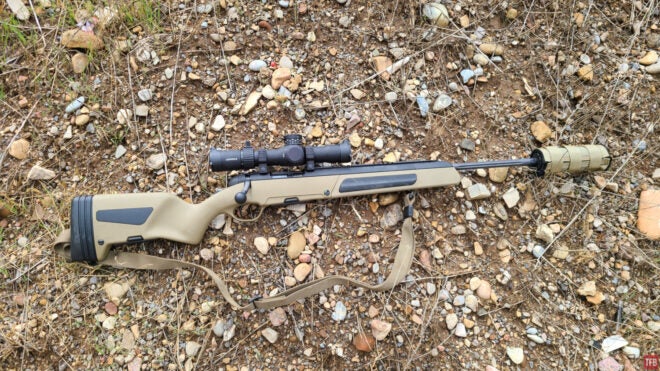The Steyr Scout Rifle is a legend. Despite being introduced in the late 1990s, it still looks like a rifle from the future. But does it still make sense to own one now? We are living in the golden age of bolt action rifles, with PRS guns performing feats of accuracy that seemed impossible 20 years ago, and inexpensive hunting rifles like the Ruger American posting accuracy results that outclass custom rifles of years past. My goal in this review is to look at the Scout against the current crop of bolt guns to see if it still holds its own. Let’s get into it.
Steyr @ TFB:
- What is the (Incredibly Rare) Steyr G62 Assault Rifle?
- The Steyr AUG 24″ HBAR Barrel Is Back!
- IDEX 2023: Steyr C9-A2 MF – An Often Overlooked Austrian Handgun
- Austria Begins Issuing Upgraded Steyr AUG Rifles
- [EnforceTac 2023] The New Lightweight Piston-Operated Steyr DMR
The disclosures for this review are simple. Steyr let me borrow the rifle for review. I’m paying for the ammo. Steyr is not paying me to write this. This will be a multi-part review. Part 1 focuses on the Scout’s features and basic shooting results from a bench. Future parts will cover optics selection, additional ammunition and accuracy testing, and performance in the field.
Background
For some readers who were contemporaries with the late Col. Jeff Cooper, this is the ultimate Scout rifle. For others among us (including me), this was a gun in Counter-Strike. Whichever group you fall into, the Steyr Scout is still one of the most interesting bolt action rifles ever made.
It was built from the ground up to match Col. Cooper’s ideas about what the “one rifle” for an outdoorsman/survivalist should be. Scout rifles should be three kilograms (6.6 lbs) or less and one meter (39”) in overall length, with the ability to reload quickly via magazines or stripper clips. Iron sights and an optic with a wide field of view are also mandatory. Purists will claim that the .308 Winchester is the only acceptable chambering, but similar chamberings like 7mm-08 were also considered for countries where “military cartridges” were prohibited.
Stey’s Scout Rifle
Several other manufacturers have made their own version of the Scout concept. Some stayed close to the rules, and others took many liberties. But Steyr makes the definitive version, designed in cooperation with the Colonel himself.
The Steyr Mannlicher Scout Rifle Site is a great resource for information on these rifles. It’s also a fun trip back in time to the way websites looked when dial-up internet was common. Of note, there are pictures of Steyr Scouts being used in the Kosovo and Ukraine conflicts.
Does the Scout Rifle still make sense?
The Scout Rifle as a concept is a little dated but is still an interesting idea. I have little doubt that the concept would be slightly different if it was designed in 2023. One of the biggest differences would be in optics. We live in a world where low-power variable optics (LVPO), red dot and holographic sights, traditional rifle scopes with locking target turrets and fancy reticles, offset microdots, and prism scopes are all common. The reliability and average optical quality of those optics are also astounding compared to what was available ten or twenty years ago. We have so many things to choose from apart from a long eye relief scope or traditional hunting rifle scope.
Another area of development and change has been in cartridges, projectiles, and propellants. Heavy, high-BC bullets and faster twist rates have boosted long-range performance. Also, new calibers make the most of those components. The 6.5 Creedmoor is just such a cartridge, with a steeper shoulder angle and case design that better supports a long, sleek bullet. The 6.5 Creedmoor is also a common cartridge now. It can be found at Ace Hardware and Walmart, and like the .308, is potent enough to hunt most things in North America, or all things in North America if you are forced to live off the land and it is the only gun you have.
In my book, the .308 still makes a lot of sense because it is so ubiquitous, and cheap FMJ ammo is available. However, if you live in a place with a lot of wide open spaces, the added ammo price of the Creedmoor could be worth it. If a millennial were designing a Scout rifle today, there are good reasons to opt for the 6.5 Creedmoor paired with some other modern optic, probably an LPVO or perhaps a prism scope with an offset microdot.
Features
Steyr packed so many interesting features onto this gun that it is hard to cover them all in a succinct fashion. This is a kind of Swiss Army Knife rifle. Let’s work from muzzle to butt to try and include them all. First, the muzzle is threaded. It’s threaded 1/2×20 for legal reasons in Austria (where it is made), but Steyr sells a 5/8×24 adapter. The barrel itself is a thin contour with fluting to keep the weight down.
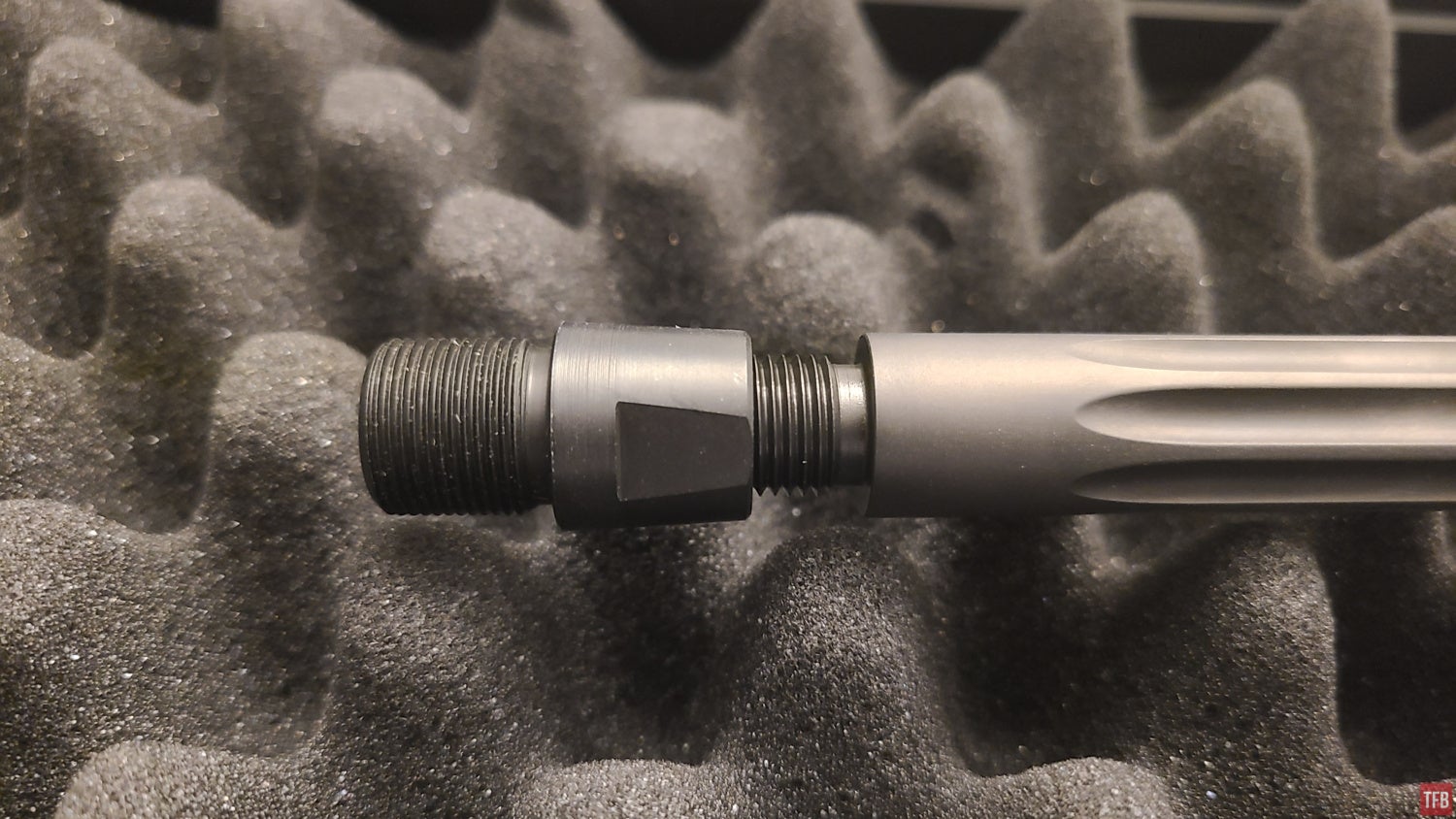
Steyr 1/2×20 to 5/8×24 thread adapter.
At the front of the stock, we find a backup front sight. An almost full-length rail with Weaver slots runs along the top of the handguard. On the underside of the stock, we find the bipod hinge and pivot, as well as the front sling loop and accessory rail. The bipod release button sits on the bottom of the stock just forward of the magazine.
Also in this vicinity is the sling mounting point for “Ching Sling” use. That style of sling uses three attachment points to create an easily accessible support loop. This loop is detachable, and I took it off for the review because that’s not a sling that I care for.
Now we reach the magazine and the receiver. The magazine is a double-feed design that holds five rounds. The most unique feature of the magazine is the additional set of locking lugs that allow it to attach to the gun but sit below the bolt so that the mag will not feed. This is a modern magazine cutoff somewhat akin to a 1903A3 Springfield or other rifles of that era. Rounds can be tossed into the action one at a time as needed, and the magazine can be pushed fully into place if rapid fire from the magazine becomes necessary.
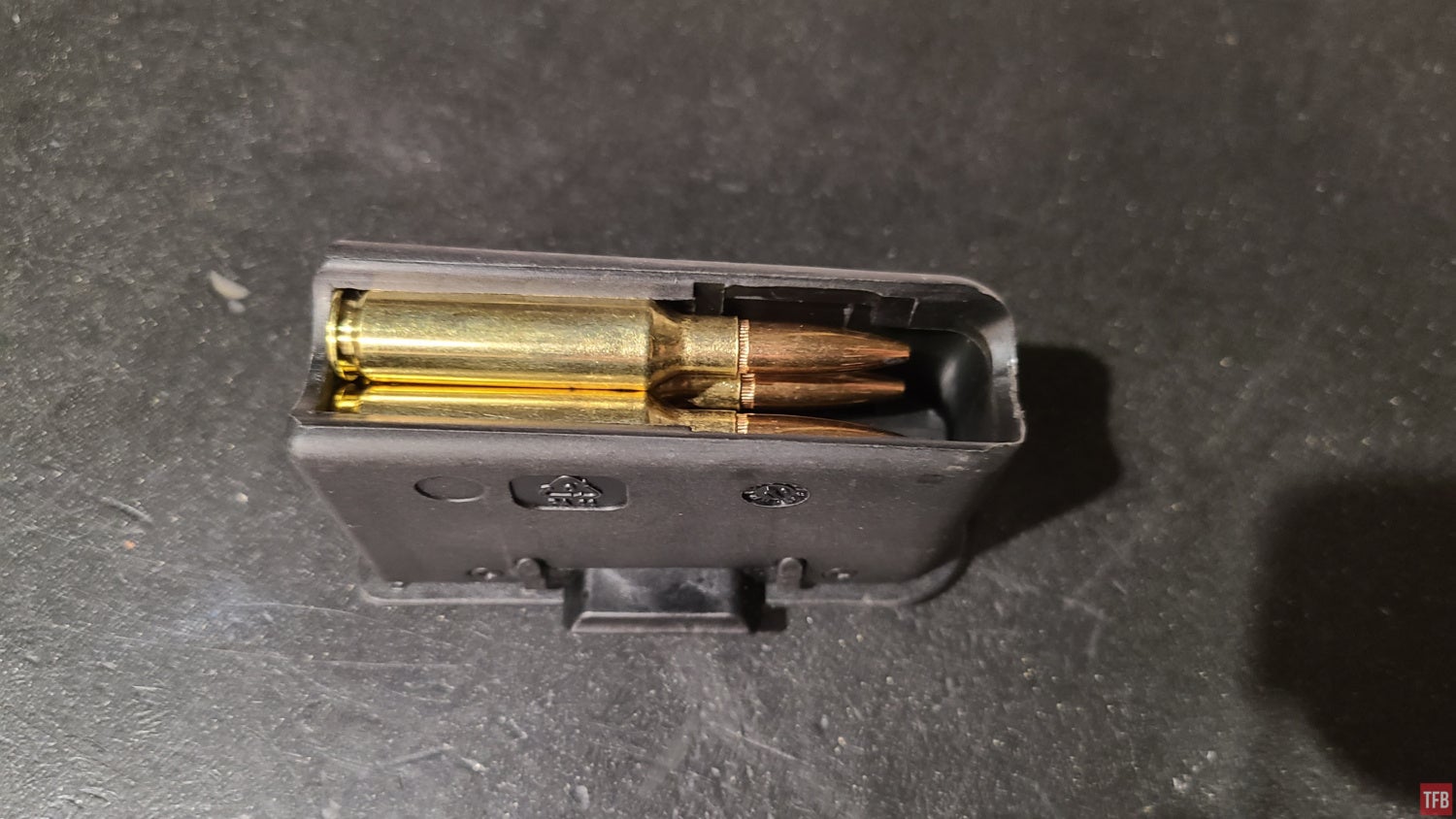
The receiver itself is aluminum. Its ejection port is large enough for easy access. There are Weaver rail segments machined into the receiver for traditional scope use. The bolt itself is fluted and very fast to manipulate. A large bolt knob makes it easy to manipulate and provides a lot of leverage.
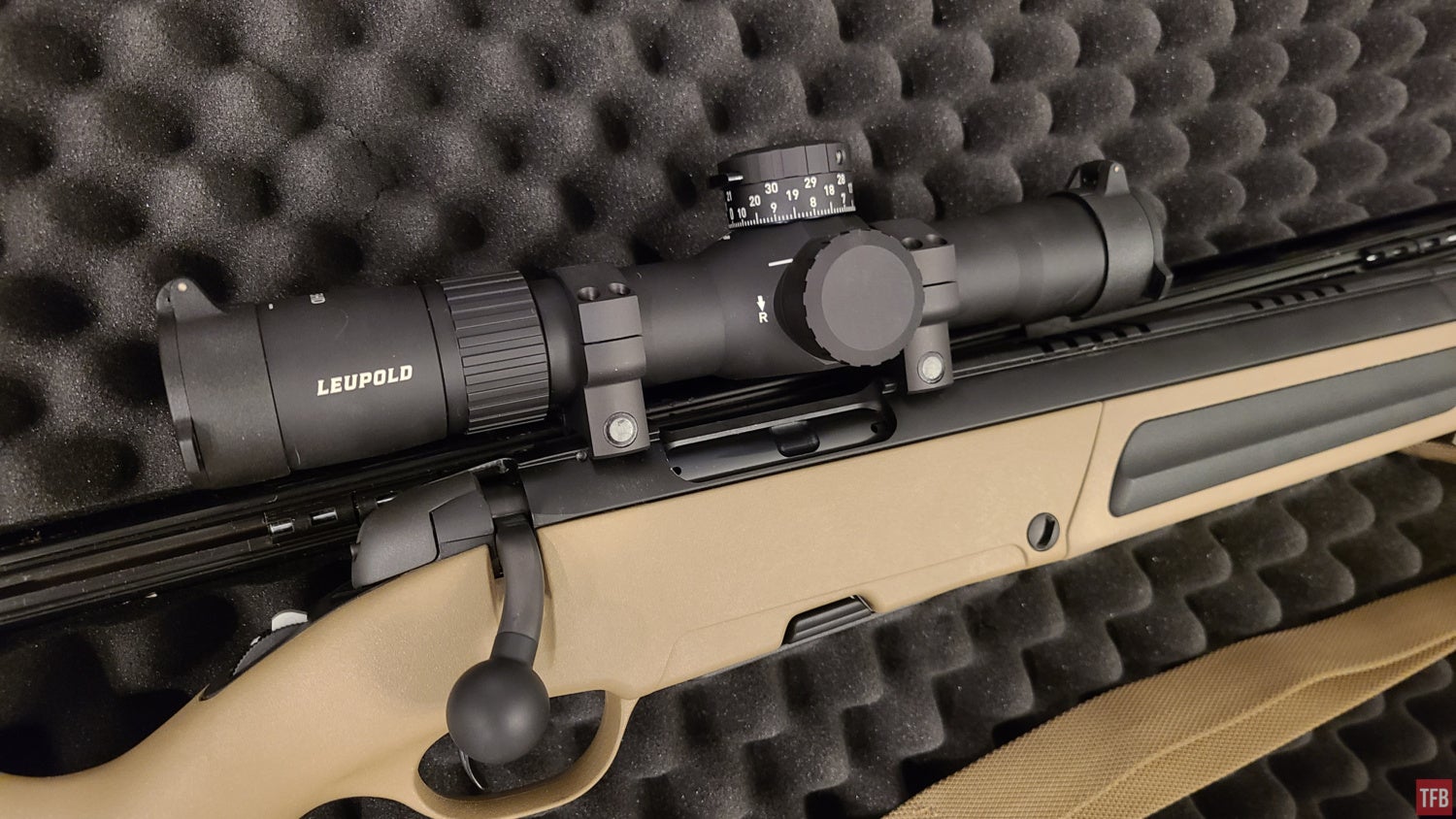
One of the standout features of the Scout is the trigger. This gun measures just over two pounds trigger pull, with a slight take up before the wall. It is a very good factory trigger and I do not believe there are any aftermarket options, probably because they would be unnecessary even for trigger snobs (which I am, too).
Steyr was creative with the safety design. This “roller tang safety is a wheel that rolls in place, sort of like a mouse scroll wheel. It has three positions: fire, safe, and safe with bolt lock. A small tab pops up in the safe with bolt lock position for added security. This design took a little getting used to but was easy to learn and get used to.
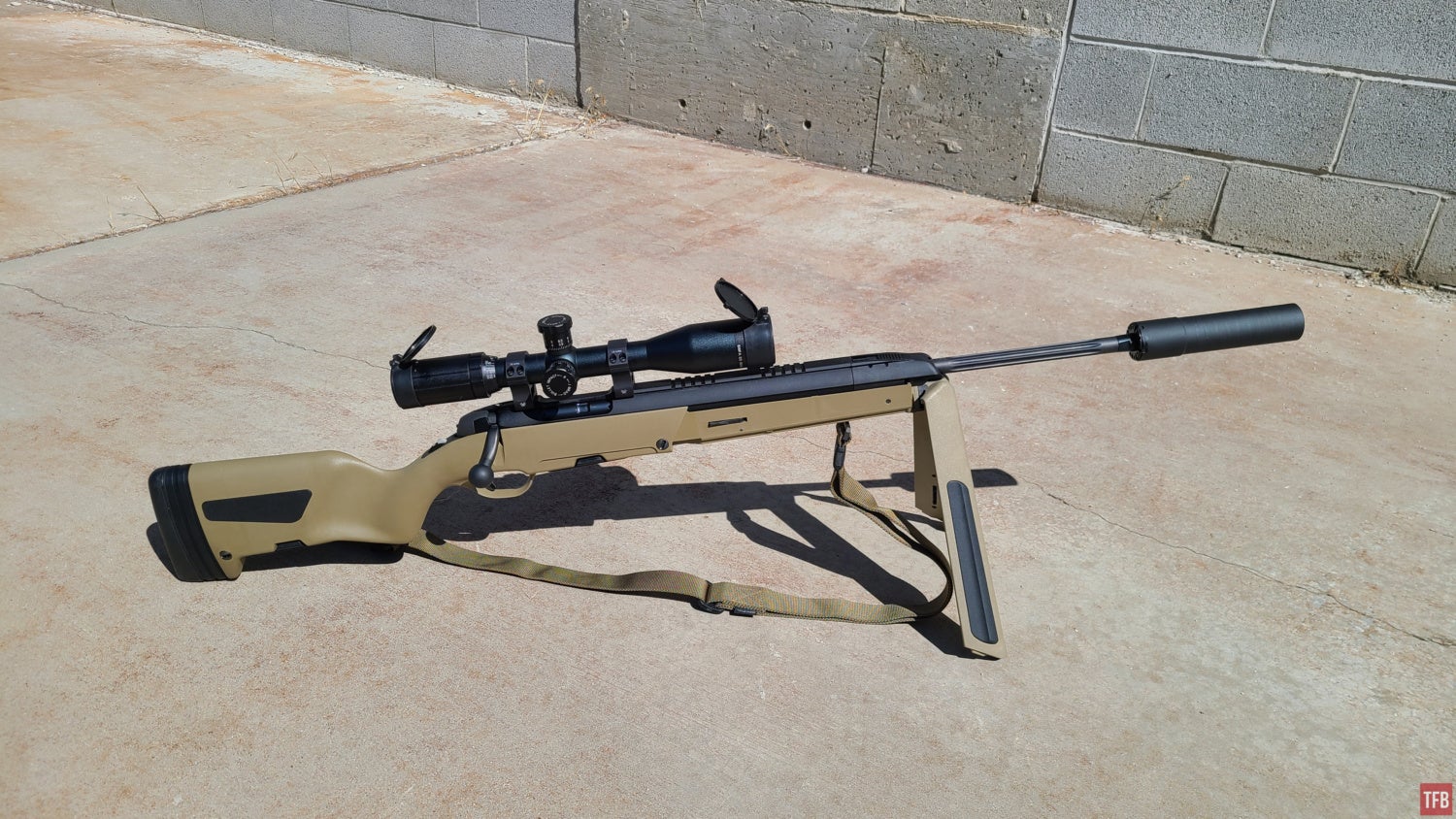
Moving back onto the stock we see a second five-round magazine. It latches into the stock just like it is another magazine well. With the spare magazine removed, there is access to a small button that releases a storage compartment door in the grip. It is small but fits things like a boresnake.
Just behind the spare magazine, there is a small hook at the toe of the stock. This is great for pushing the stock into the shoulder with the support hand while the front end of the gun is supported. And just behind that hook are the length of pull spacers. These can be removed for shooters who want a reduced length of pull, but I found the Scout comfortable to use in the configuration provided and I left the spacers in.
Ammo Testing
I wanted to test a wide variety of ammo to see what the Scout was capable of. For all of this testing, I used an SWFA 10X scope and had a SilencerCo Harvester Evo attached, and a MagnetoSpeed Sporter to collect the data. Note that suppressors do tend to boost velocity slightly compared to a bare muzzle. I fired three 5-round groups at 100 yards from a Caldwell Precision Turret rest with each ammunition type, and the ambient temperature was around 90 degrees.
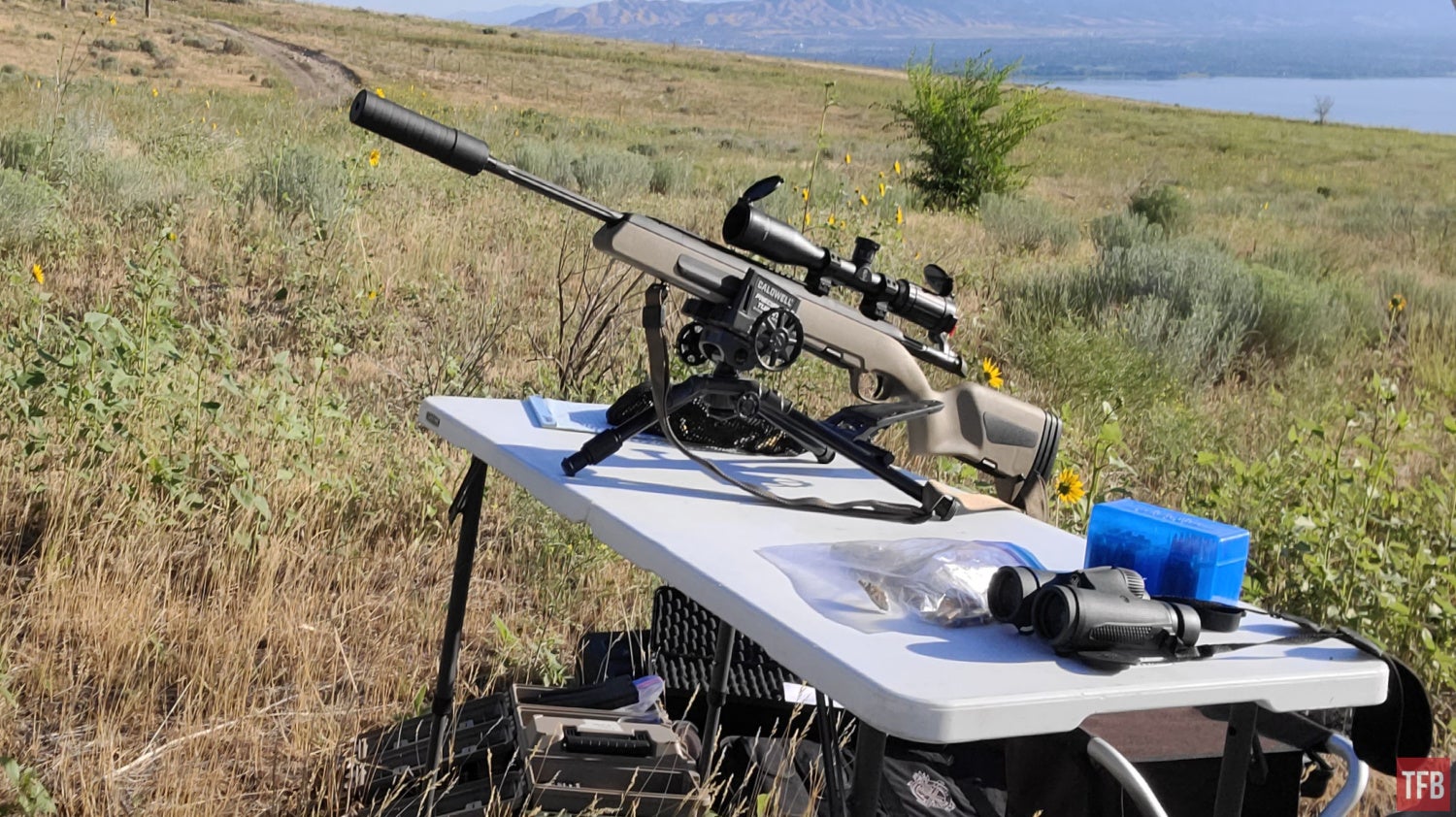
I used a Caldwell Precision Turret Rest for the accuracy testing.
| AMMO | GROUPS (IN) | AVG GROUP | AVG FPS |
| Federal 120gr OTM | 1.47, 1.51, 1.2 | 1.39” | 2795 |
| Winchester 125gr Deer Season XP | 1.81, 0.82, 2.37 | 1.67” | 2702 |
| Winchester 129gr Power Point | 1.92, 3.07, 2.15 | 2.38” | 2663 |
| Winchester 140gr OTM | 1.38, 0.98, 1.16 | 1.17” | 2587 |
| Remington 140gr Core Lokt | 1.3, 1.37, 1.42 | 1.36” | 2585 |
| S&B 156gr Soft Point | 1.75, 1.59, 1.64 | 1.66” | 2368 |
I discussed these results with Steyr. They have a Sub-MOA guarantee for a three-round group and a testing protocol with four rounds into a 20mm group (0.78-inches) with Hornady Precision Hunter 143-grain or Federal Gold Medal Match 140-grain. I chose to do 5-round groups because it has a five-round magazine, but I did consider three-round groups as well. Generally, 5-round groups are more indicative of a rifle’s true accuracy. However, with a thin barrel profile, heat becomes an issue and later shots in a group will tend to spread out. I attempted to mitigate this by leaving several seconds between shots and cooling the rifle between groups, but it was summer in the desert so there was not a lot of cooling to be had.
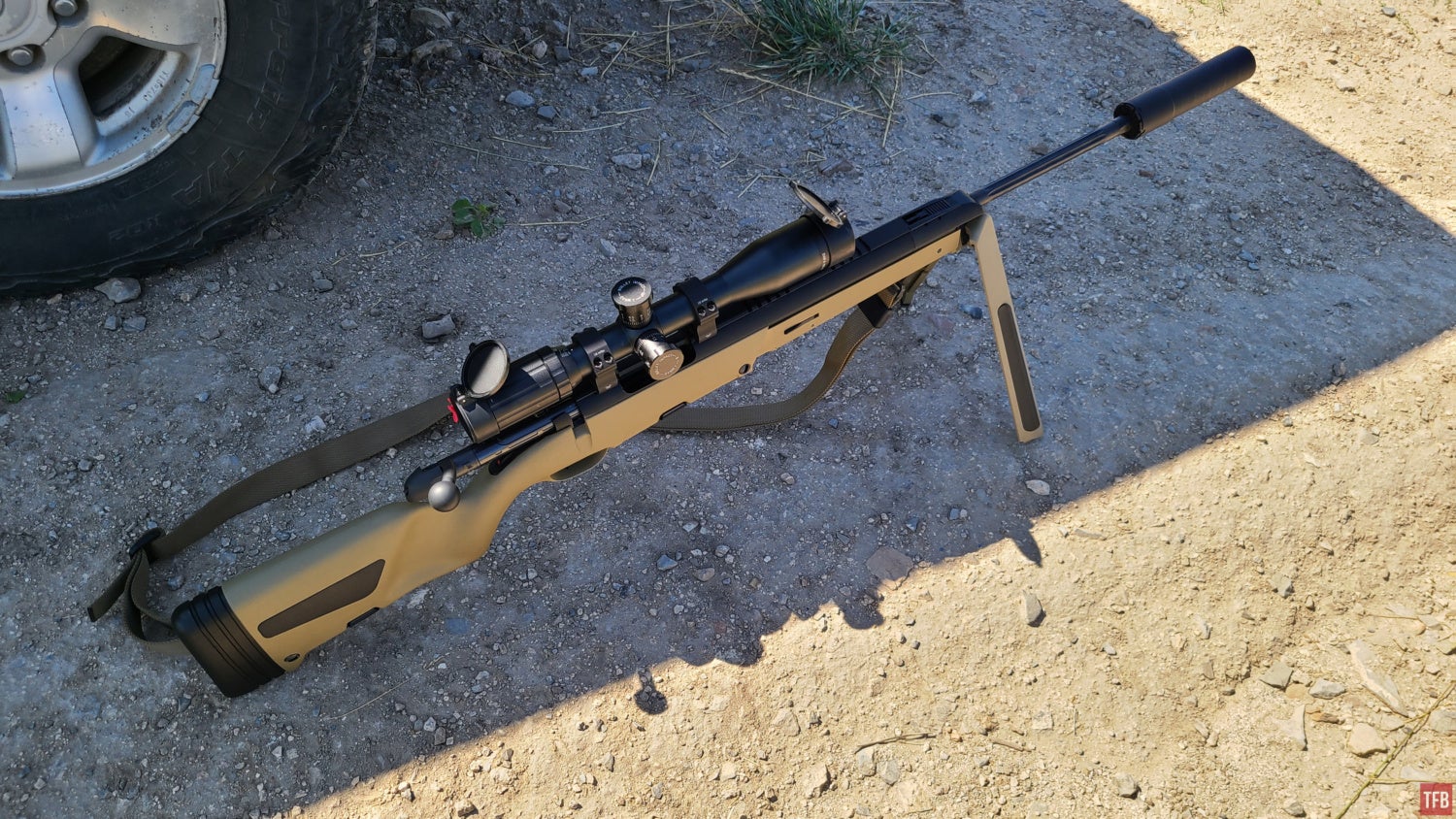
Trying my best to cool down the rifle between strings in the limited shade I could find.
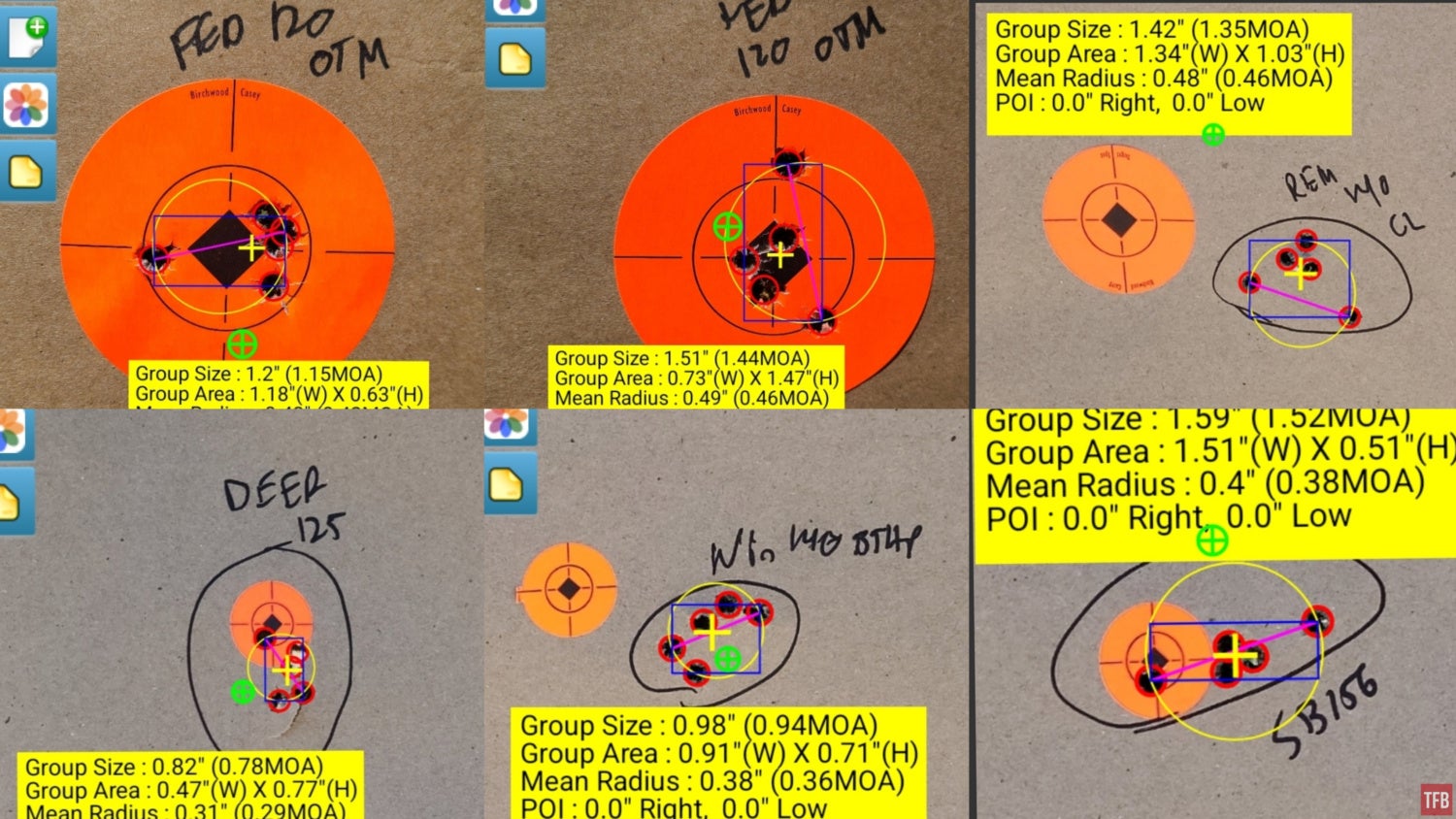
Some examples of the groups fired. Note that with several of the groups, there appears to be a three-round group with two flyers.
Initial Impressions
I may still be in the honeymoon phase with this gun, but it is superb. This is not to say there are no design trade-offs and it is perfect in every possible way. Lightweight rifles are easier to carry than to shoot in most instances. They trade some degree of accuracy in exchange for portability. All rifles have rearward movement from recoil before the bullet leaves the bore and this is more pronounced on light rifles than on heavy rifles because of physics. Heavy rifles are also less susceptible to jostling by the shooter and heavy barrel profiles tend to keep shot groups tighter as the barrel gets hot.
The real trick to a rifle like the Steyr Scout is finding that balance between accuracy and portability. My competition service rifle has lead weights in the stock and handguard and weighs about 15 pounds. It is very easy to shoot well, but is a pain to even carry between different firing lines. In contrast, the Scout is a rifle that you appreciate more the longer you carry it because it is balanced and light.
It is quite accurate, particularly for the first three, four, or maybe five rounds, depending on ammo selection. And while it will not group the same as a PRS rifle for shots #6-10, those are not nearly as important to the Scout’s role as they are for something like a heavy tactical rifle. Being portable and easy to carry means you are more likely to have it when you need it or are more able to get to places where the animals might be. If those considerations matter to you, the weight and general user-friendliness of the Steyr Scout count for quite a lot.
Conclusion
That’s it for Part 1. This is not the end of the story, but thus far I am absolutely in love with this rifle. It is possible that will change as I spend more time with it. However, I do not think that will happen. To use a dating analogy, we are several months into a relationship, I’ve seen her without makeup, and I want to keep seeing her as often as I can. Stay tuned for Part 2 (testing various optics) coming very soon.
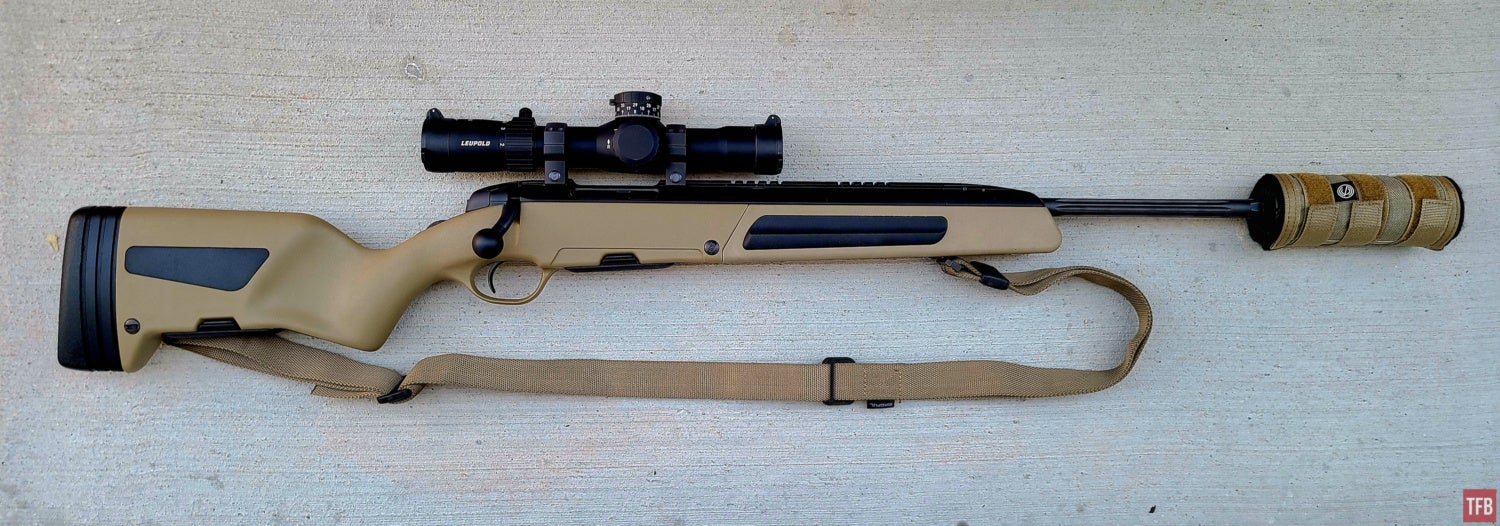
This is probably the Steyr Scout setup I will use for hunting this year: Leupold Mk5HD 2-10, Magpul RLS sling, and SilencerCo Harvester Evo.
We are committed to finding, researching, and recommending the best products. We earn commissions from purchases you make using the retail links in our product reviews. Learn more about how this works.
 Your Privacy Choices
Your Privacy Choices
